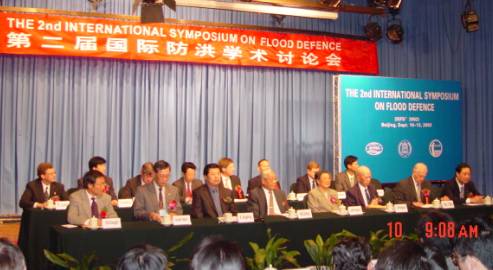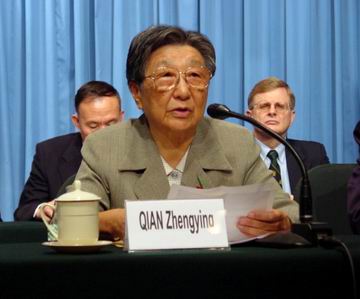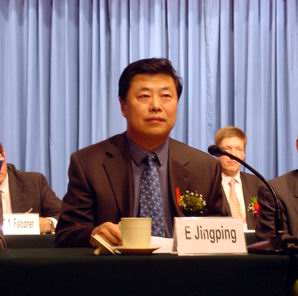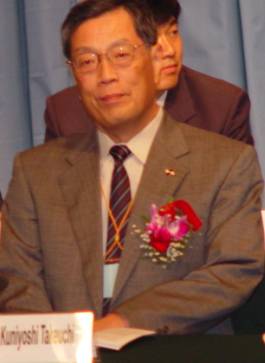|
¡¡ |
|||
|
¡¡
Conference Report Second International Symposium on Flood Defence The ¡°Second International Symposium on Flood Defence¡± was held in the China Hall of Science and Technology, Beijing China from 10 ¨C 13 September 2002. The Tsinghua University, the Research Center on Flood and Drought Disaster Reduction of the Ministry of Water Resources of China, the China Institute of Water Resources and Hydropower Research and the International Research and Training Center on Erosion and Sedimentation, are the organizers of the conference. The symposium attracted more than 200 researchers, practitioners, educators and public officials working or interested in flood control from about 35 countries and regions. At the opening ceremony, Madame Zhengying Qian, vice president of the Chinese People¡¯s Political Consultative Conference, Mr. Jingping E, Secretary-general of the State Flood Control & Drought Relief of China, and vice minister of the water resources of China, Dr. Erich Plate, ex-president of the International Association for Hydraulic Engineering Research, Prof. Kuniyoshi Takeuchi, the president of the International Association for Hydrological Sciences, Prof. van Stokkom, Director of the East Netherlands Department of the Ministry of Transport, Public Works and Water Management, Mr. Richard Reidinger, Water Resources Economist of the World Bank, and Prof. Zhangzhi Cen, Vice president of the Tsinghua University made opening addresses. Qian Zhengying said China's flood protection strategies are moving from fighting floods living with floods in a sustainable manner. Only by finding outlets for massive seasonal floodwaters can China develop its estimated 1 million square kilometres of populous and fertile alluvial river plains and be in harmony with floods. The symposium provided a forum for reviewing the state-of-the-art of the studies on flooding and engineering and non-engineering strategies. It focused on a better understanding of flooding and environmental problems, different perspectives evolved, climate change and its impact on extreme hydrological events, and reporting new approaches to the study and flood control strategies. This aspect of the Symposium was highlighted by eleven keynote and ten invited papers given by distinguished international scientists and roughly three hundred contributed manuscripts. The symposium provided also a chance for the participants to see the development of hydraulic engineering in China. During the conference, a standing committee of International Symposia on Flood Defence was erected. The tasks of the committee are to review the state-of-art of the studies on flooding and engineering and non-engineering strategies, select the theme, venue and organizers of the symposia. In the first committee meeting, Dr. Erich Plate was elected as the chairperson, an office of the secretariat was decided to be established and maintained at the Research Center on Flood and Drought Disaster Reduction of the Ministry of Water Resources of China, and the next symposium was decided to be held in the city of Nijmegen, the Netherlands in the Spring of 2005. The keynote and invited lectures were outstanding. While the numbers and content of them are too extensive to summarize here, only the titles of the keynote lectures are listed: Erich Plate, University of Karlsruhe, Germany: Early warning system of the Mekong Kuniyoshi Takeuchi, Yamanashi University, Japan: Floods and society, a never-ending evolutional relation Ir. Hein van Stokkom, the East Netherlands Department of the Ministry of Transport, Public Works and Water Management, the Netherlands: Flood defence in the Netherlands; a new era, a new approach Roger A. Falconer, Cardiff University, U.K.: Catchment Flood Management: a U.K. Perspective and Experience Pierre Julien, Colorado State University, USA: Flashflood and sediment transport modeling of small watersheds Bella Petry, International Institute for Infrastructural, Hydraulic and Environmental Engineering, the Nertherlands: Flood defense issues and strategies-the complementary character of structural and non-structural measures to cope with floods Yeou-koung Tung, Hong Kong University of Science and Technology, Hong Kong, China: Risk-based design and analysis of flood defence systems Colin Green, representative of the World Bank: Flood Management from the Perspective of Integrated Water Resource Management Wolfgang Kron, Munich Reinsurance Company, Germany: Flood Disasters and Insurance: Flood risk = hazard ´ exposure ´ vulnerability Joseph H.W. Lee, the University of Hong Kong, Hong Kong, China: Urban flood control in Hong Kong Xiaotao Cheng, the Research Center on Flood and Drought Disaster Reduction of the Ministry of Water Resources of China. China: Changes of flood control situations in the coastal region of China and adjustments of flood management strategies The two volumes of the proceedings published by the Science Press New York Ltd contain the keynote and invited lectures and selected papers. The contents of the papers seem to cover nearly everything on flood management. The symposium books (US$100.00) and the CD ROM (US$10.00) of the proceedings can be obtained by writing to: Dr. Cheng
LIU or Dr.
Baosheng Wu
Opening Ceremony
Zhengying Qian, vice president of the Chinese People¡¯s Political Consultative Conference
Jingping E, Secretary-general of the State Flood Control & Drought Relief of China, and vice minister of the water resources of China
Erich Plate, ex-president of the International Association for Hydraulic Engineering Research
Kuniyoshi Takeuchi, the president of the International Association for Hydrological Sciences
Hein T.C. van Stokkom, Director of the East Netherlands Department of the Ministry of Transport, Public Works and Water Management REPORT FROM CHINADAILY New flood theory proposed (LIANG CHAO) 09/11/2002 Humans should learn to live peacefully with floods by adjusting their traditional control concepts of trying to beat the natural disasters, experts said yesterday. During the second International Symposium on Flood Defence, which started in Beijing yesterday, they urged a move away from the concept of fighting floods to a concept of flood management. So far this year, floods have swept over central and eastern Europe and caused huge losses in Germany, Russia, Austria and the Czech Republic. In China, floods hit the Yangtze River this summer, claiming more than 1,500 lives, affecting about 190 million people and leaving a repair bill of nearly 68 billion yuan (US$8.2 billion). The experts said it is no longer possible to protect citizens against floods. Instead, they must learn to live with the disasters, instead of only using passive measures like dikes to deal with them. Although flooding is posing increasing threats to many countries, they said humans can live with the disasters by trying to use the water left behind by floods. An estimated 200 flood management experts are attending the four-day forum. Over half of them are from about 30 countries and regions facing flood-related problems. They expect the conference, the first of its kind held in China, will offer advice to scientists and administrators on the direction that needs to be taken for the world to live with flooding and to provide leadership for a better approach to flood management. During the conference, the experts will also exchange ideas and learn about other related issues like flood modelling, the environmental impact of flooding and flood insurance. "Let us join hands to contribute to the use of sustainable water resources and make our world a better place to live in," an unidentified, leading Chinese water expert said. Addressing the group, Qian Zhengying, from the Chinese Academy of Engineering Sciences, said China's flood protection strategies are in flux, moving from fighting floods in an untempered way to living with them in an orderly and sustainable manner. "Only by finding outlets for massive seasonal floodwaters can China develop its estimated 1 million square kilometres of populous and fertile alluvial river plains and be in harmony with floods," Qian said. During recent flood seasons, a low discharge of floodwater usually causes high water levels on China's major rivers like the Yangtze, which has been affected by human activities. For example, the reclamation of land and marshy areas around the river have decreased the Yangtze's flood discharge capacity. China has a history of fighting with floods, particularly in its vast alluvial river plains where land is so rich and populous. But only with the protection of dikes and levees along the rivers can people survive. ¡¡
¡¡ |
||||
| Previous page | Next page | Home page | ¡¡ ¡¡ |
|






